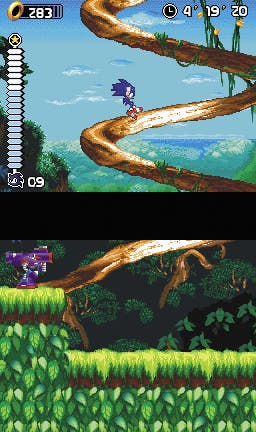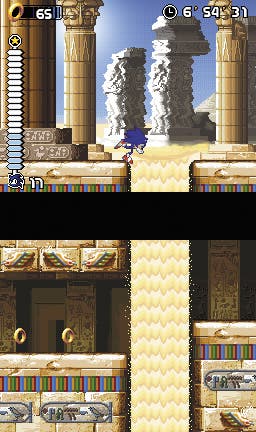Sonic Rush
Hedgehog's limelight.
Here are two things you can do, SEGA, to make ALL of your Sonic games better and instantly more appealing to human beings:
- Stop killing me with one hit.
- STOP KILLING ME WITH ONE HIT.
Do the devs actually think that the best way to treat the player after he's ridden a tricky moving platform and struck a bounce pad is to plant an annoying flying enemy directly in Sonic's flight-path so that, when struck, Sonic will bounce directly into an unavoidable bottomless pit, killing the player? Or that having Sonic speed under a descending metal block without warning, and not leaving him enough time to escape before it kills him with one squishy blow, is good game design? Or that directing a boss character to kill Sonic with one unexpected strike three minutes into the encounter is somehow also very clever? And that a system that forces you to restart a Zone if you run out of lives before the end of the second stage won't somehow accentuate these things?
Because, I'm here to tell you, none of this stuff makes me smile. None of it makes me think, "Well boy howdy, let's whack a 9 on the end of this review." (Come to think of it, there's not a lot in life that makes me think, "Well boy howdy anything," but the point remains.) It would be nice to think I'm not the only person in the world who reckons forcing somebody to lose BY DESIGN is stupid.
Fortunately, Sonic Rush is a well-made platform game in spite of the abovementioned stupidity.
Forget the fact that it's using both screens. While you'll have to switch your focus from one to the other occasionally when the game moves you up or down, there's very little distinct benefit. From time to time, you'll find yourself on a rising platform and the top-screen will show you the switch you'll need to hop off and press before hopping back on, but it's rarely more complicated than that.

Forget newcomer Blaze the Cat too. She doesn't really do anything hugely different to Sonic, despite taking things on in a different order.
And forget the allusions to the DS's greater graphical might. The 3d elements are superficial, and when they actually affect gameplay only really introduce a Final Fight level of world depth.
Nope - what makes Sonic Rush so good is that the devs, the chaps who did the Sonic Advance games on GBA, seem to have a lot of good ideas for things Sonic could be doing above and beyond what he did on the Megadrive. (Unlike SEGA itself, judging by the last few 3d efforts.)
There's a Super Boost button ("Rush", surely?), which propels Sonic forward at super speed, enveloped in blue flame, and with enough force to clobber any enemy and bash through obstacles. Super Boost is built up in a meter on the left of the screen, which is fuelled by the slaying of your robot foes, and the performing of tricks whilst in mid-air. Tricks? Yes - arguably a bit silly, but a good thing to remember. And learning when to use Super Boost, whipping it out just in time to clobber an enemy instead of dropping most of your accumulated rings (the only other barrier to one-hit-kills, lest anyone forget), is a rewarding feeling.
Really though, even that... For all the new stuff you can do in Sonic Rush, it's the way the old stuff's done that satisfies most. The levels that mix precise, timed platforming and rudimentary puzzle-solving. The use of common level elements in greater concert and with variation. Overcoming this stuff consumes you in the way that good platform games should.
Example: In one level, you hit a switch to activate a moving platform and then ride it to the other side of a pit. You also hit a switch to briefly activate greyed-out platforms to hop between and rails to grind. Later, you do all of this while dodging enemies. Later-later, you do these things in combination. And so on. All the while you are sprinting very fast between each bit, riding ramps, dodging stuff and generally doing what Sonic does in colourful, imaginatively drawn environments.

If you list this stuff bit by bit it sounds tedious - moving platforms, switch-platforms, trapeze-swinging, bounce-pads, rooms of enemies. So too do the environments - grass level, water level, carnival level. But it's fast and energetic and the controls are simple and responsive, it makes good use of all your available skills in the right ways, and it presents layered levels that reveal their secrets in the face of intuition, KGB-level reactions and a decent memory. With the boost and tricks making an appreciable, if not exactly zeitgeist-redefining difference to the proceedings.
Oh, and despite a few insta-deaths, the bosses are actually very well designed, and actually capable of surprising you on second attempts by wheeling out new attack patterns to keep you on your toes.
It's a good Sonic game. Probably the best 2d one since the olden days.
But of course it is a Sonic game, so what I said at the start still holds true. As much as I might admire the precise way everything's been put together, and enjoy compulsively dispatching Zone after Zone, I still can't abide the way it builds you up and then runs you straight into someone's swinging baseball bat without warning. Completing Sonic Rush and only experiencing relatively tolerable levels of frustration demands a very good memory and very quick reactions. Completing it without actually being unfairly frustrated by it at all demands precognition. And frankly, people with precognitive ability have better things to do than playing this - like standing where they know Kylie Minogue is going to try and lick her ice-cream in a couple of minutes.
And, as with most of the other Sonic games, there's also a sense that you're being carried rather more than you're doing things for yourself. In older Sonic games, well-timed jumps were of critical importance to uncovering the best available route to progression. In recent Sonic games, Rush in particular, actually controlling your own destiny can feel like an afterthought.
Which, when you put into the context of a game that likes killing you, and doesn't really do anything fantastically new and inspirational, is cause to frown a little - even if you really do enjoy a lot of the things you clearly are controlling.
So then, Rush will be well liked, and deserves to be. But Sonic isn't his own genre, and unfortunately for the end score, a lot of the stuff he competes against got past a lot of his problems a long time ago.

